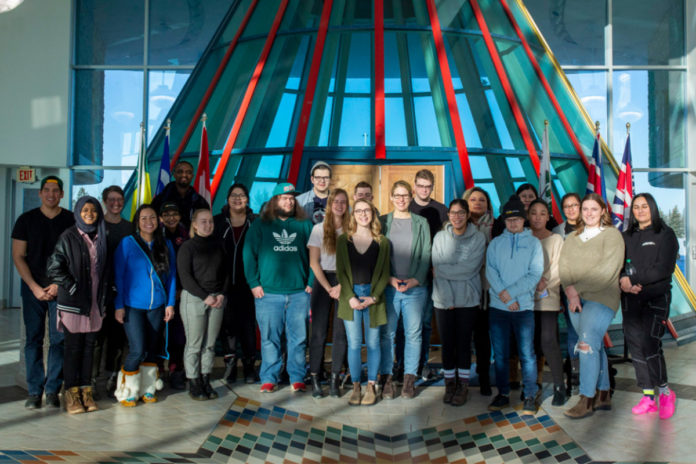
Students at the University of Regina, Concordia University in Montreal, Que. and First Nations University of Canada (FNUniv) are taking a closer look at the First Nations water crisis in Saskatchewan, contributing to a new era of investigative journalism in Canada.
The project is led by the Institute for Investigative Journalism (IIJ) at Concordia, producing over 30 articles and broadcast programs including an hour-long documentary investigating the safety of drinking water in Saskatchewan and the rest of Canada.
The film, titled Broken Promises, was released Feb. 22, after over a year of production by students in a broadcast course at U of R and collaboration with student researchers at FNUniv.
The documentary spotlighted the history of colonialism and the failure of political policy behind the undrinkable water crisis in many First Nations communities, speaking to community members living in the communities.
Currently in Saskatchewan there are seven long-term drinking water advisories in five First Nations communities. These advisories caution people to boil the water, before they use or consume it.
Resource extraction in nearby areas is linked to the poor quality of drinking water sources, and the forced relocation of many communities to places with contaminated water.
“One of the main focuses of the [investigation] was to look at [what] the investments made by the Trudeau government has done for First Nations communities,” said Annie Burns-Pieper, managing editor of IIJ.
Through their investigation, students uncovered that First Nations communities in Saskatchewan are receiving little help from the government to recover the poor water quality.
“The Canadian government has constantly ignored First Nation communities or given them hardships,” said Adam Bent, member of the project and a journalism student at U of R. “They’re not fulfilling the goals they set out.”
The project was made possible by over 100 students and faculty at 10 campuses across Canada, working with news outlets to conduct the investigation. With a large team, came challenges Burns-Pieper said provided a learning curve for all participants.
“Anytime you’re working in a large collaboration, there can be communication and coordination challenges, and especially this year because we’re dealing with the pandemic,” Burns-Pieper said, “but the findings really have a larger impact because we’re working together.”
Students worked on the investigation for over a year in multiple classes at FNUniv and U of R, conducting research and receiving course credits for the stories they produced.
The investigation was the second set of stories and programs in a two-year effort to investigate the safety of drinking water in Saskatchewan and across Canada. In the first year, students at IIJ looked at lead contamination in water across Canada and found little information about water conditions in First Nations communities, leading the program to expand its team and scope.
Erica Endemann, a master of journalism student at Carleton University, was a part of the previous project with IIJ, and previously worked with IIJ fellows and students across Canada. Endemann said the success of this year’s project success was made possible with the efforts of the many journalists participating, researching and finding stories.
“[Through collaboration], there’s a wider scope that we’re able to cover,” Endemann said.
The team of journalists experienced their greatest roadblock in production when the pandemic hit, disrupting communication and their ability to film in person.
“COVID-19 hitting in the middle of an investigative project like that was definitely a curveball that none of us expected,” said Libby Giesbrecht, a journalism student at U of R. She noted some students were forced to postpone their projects.
With setbacks from the pandemic, Concordia research fellow Jaida Beaudin-Herney said she has been unable to finish her portion of the project, which is now centred on COVID-19’s impact on drinking water quality on First Nations communities.
As a Mi’kmaq and Cree woman from Membertou First Nation in Nova Scotia, Beaudin-Herney expressed the importance of reporting on issues that affect Indigenous peoples, and hopes that their findings will help educate the public about the water crisis in Canada.
“I’m given an opportunity to show my skills and put a voice that was not really represented in news media … which is an Indigenous voice,” Beaudin-Herney said.
Although many of the project’s reporters were members of First Nations communities, faculty also emphasized the importance of instructing non-Indigenous journalists on respectfully and accurately reporting on Indigenous communities.
“We were working with a lot of people who have not reported on Indigenous communities before, and we believe that a lot of the reporters gained skills to do more work on Indigenous communities,” Burns-Pieper said.
The team said they hope their investigative work will demonstrate to Canadians the severity of the drinking water crisis in First Nations communities and plan to continue developing student journalists’ investigative skills.
“[Journalists] are supposed to be the watchdogs for our democratic society,” Giesbrecht said. “We have the opportunity through this being our jobs to look into things that don’t seem right.”
Featured image by Kaitlyn Schropp.





